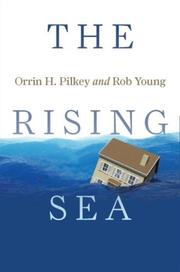| Listing 1 - 6 of 6 |
Sort by
|

ISBN: 1597266434 9781597266437 9781597261913 1597261912 9781610910040 1610910044 Year: 2009 Publisher: Washington, D.C. : Island Press/Shearwater Books,
Abstract | Keywords | Export | Availability | Bookmark
 Loading...
Loading...Choose an application
- Reference Manager
- EndNote
- RefWorks (Direct export to RefWorks)
While rising seas are now inevitable, we are far from helpless. By making hard choices--including uprooting citizens, changing where and how we build, and developing a coordinated national response--we can save property, and ultimately lives. With unassailable research and practical insights, The Rising Sea is a critical first step in understanding the threat and keeping our headsabove water.
Book
ISSN: 22110577 ISBN: 9400741227 940079360X 1283633698 9786613946140 9400741235 9789400741232 9781283633697 Year: 2012 Volume: v. 3 Publisher: Dordrecht ; New York : Springer,
Abstract | Keywords | Export | Availability | Bookmark
 Loading...
Loading...Choose an application
- Reference Manager
- EndNote
- RefWorks (Direct export to RefWorks)
At the coast all is not what it seems. Decades of beachfront development have seen a variety of efforts to stabilize the shoreline to protect ill-placed beachfront property, both from shoreline erosion and from storm damage. Both of these problems become increasingly critical in a time of rising sea level. Many natural beaches are backed by sea walls, while others have been transformed by whole series of groynes, offshore breakwaters and a plethora of other schemes. Many recreational beaches are actually artificial replicas of the real thing, emplaced to protect badly placed infrastructure and maintained only through ongoing costly beach nourishment. However, all of these attempts to stabilize the shoreline are far from benign. Degradation and even complete loss of the all important recreational beach sometimes results from seawall emplacement. Increasingly, the choice of shoreline stabilization approach will depend upon plans for future response to rising seas which in many cases may involve retreat from the shoreline rather than holding the line. This book explores, through a series of case studies from around the globe, the pitfalls of shoreline stabilization and provides a ready reference for those with an interest in shoreline management. It is particularly timely in a time of global change.
Shoreline. --- Earth & Environmental Sciences --- Mechanical Engineering --- Engineering & Applied Sciences --- Hydraulic Engineering --- Marine Science --- Shore protection --- Shorelines --- Soil stabilization --- Stabilization of soils --- Lake shorelines --- Lakes --- Reservoirs --- Shore-lines --- Beach erosion --- Coast protection --- Coast protective works --- Prevention --- Earth sciences. --- Oceanography. --- Geobiology. --- Coasts. --- Physical geography. --- Earth Sciences. --- Coastal Sciences. --- Biogeosciences. --- Physical Geography. --- Earth Sciences, general. --- Physical geography --- Seashore --- Bodies of water --- Coastal zone management --- Coastal engineering --- Hydraulic engineering --- Reclamation of land --- Soil mechanics --- Stability --- Reinforced soils --- Slopes (Soil mechanics) --- Soil compaction --- Soil consolidation --- Subsurface drainage --- Geography. --- Cosmography --- Earth sciences --- World history --- Geography --- Oceanography, Physical --- Oceanology --- Physical oceanography --- Thalassography --- Marine sciences --- Ocean --- Geosciences --- Environmental sciences --- Physical sciences --- Biology --- Biosphere --- Coastal landforms --- Coastal zones --- Coastlines --- Landforms

ISBN: 1281790184 9786613791153 0231506996 9780231506991 0231132123 9780231132121 9781281790187 Year: 2007 Publisher: New York : Columbia University Press,
Abstract | Keywords | Export | Availability | Bookmark
 Loading...
Loading...Choose an application
- Reference Manager
- EndNote
- RefWorks (Direct export to RefWorks)
Writing for the general, nonmathematician reader and using examples from throughout the environmental sciences, Orrin Pilkey and Linda Pilkey-Jarvis show how unquestioned faith in mathematical models can blind us to the hard data and sound judgment of experienced scientific fieldwork. They begin with the extinction of the North Atlantic cod on the Grand Banks of Canada, and then they discuss the limitations of many models across a broad array of crucial environmental subjects. Case studies depict how the seductiveness of quantitative models has led to unmanageable nuclear waste disposal practi
Environmental protection --- Environmental policy --- Ecology --- Environment and state --- Environmental control --- Environmental management --- Environmental quality --- State and environment --- Environmental auditing --- Environmental quality management --- Protection of environment --- Environmental sciences --- Applied ecology --- Environmental engineering --- Decision making --- Mathematics. --- Mathematical models. --- Government policy
Book
ISBN: 1283278014 9786613278012 0520948947 9780520948945 9780520268715 0520268717 9780520268722 0520268725 9781283278010 Year: 2010 Publisher: Berkeley : University of California Press,
Abstract | Keywords | Export | Availability | Bookmark
 Loading...
Loading...Choose an application
- Reference Manager
- EndNote
- RefWorks (Direct export to RefWorks)
Take this book to the beach; it will open up a whole new world. Illustrated throughout with color photographs, maps, and graphics, it explores one of the planet's most dynamic environments-from tourist beaches to Arctic beaches strewn with ice chunks to steaming hot tropical shores. The World's Beaches tells how beaches work, explains why they vary so much, and shows how dramatic changes can occur on them in a matter of hours. It discusses tides, waves, and wind; the patterns of dunes, washover fans, and wrack lines; and the shape of berms, bars, shell lags, cusps, ripples, and blisters. What is the world's longest beach? Why do some beaches sing when you walk on them? Why do some have dark rings on their surface and tiny holes scattered far and wide? This fascinating, comprehensive guide also considers the future of beaches, and explains how extensively people have affected them-from coastal engineering to pollution, oil spills, and rising sea levels.
Beaches. --- Seashore. --- Coasts. --- Coast changes. --- Coastal erosion --- Coasts --- Shore erosion --- Littoral drift --- Physical geography --- Coastal landforms --- Coastal zones --- Coastlines --- Landforms --- Seashore --- Sea shore --- Sea shores --- Seashores --- Shore, Sea --- Shores, Sea --- Beaches --- Erosion --- Coast changes --- arctic beaches. --- bars. --- beach ecosystems. --- beach environments. --- beach guides. --- beach variety. --- beaches. --- berms. --- blisters. --- coastal engineering. --- color photographs. --- cusps. --- dunes. --- earth sciences. --- global beaches. --- guidebook. --- illustrated. --- maps. --- natural sciences. --- natural variety. --- nonfiction. --- oceans. --- oil spills. --- pollution. --- ripples. --- rising sea levels. --- scientists. --- shell lags. --- shorelines. --- tides. --- tourist destinations. --- tropical shores. --- washover fans. --- waves. --- wind. --- wrack lines.
Book
ISBN: 0231541805 9780231541800 0231168446 9780231168441 Year: 2016 Publisher: New York, [New York] : Columbia University Press,
Abstract | Keywords | Export | Availability | Bookmark
 Loading...
Loading...Choose an application
- Reference Manager
- EndNote
- RefWorks (Direct export to RefWorks)
Melting ice sheets and warming oceans are causing the seas to rise. By the end of this century, hundreds of millions of people living at low elevations along coasts will be forced to retreat to higher and safer ground. Because of sea-level rise, major storms will inundate areas farther inland and will lay waste to critical infrastructure, such as water-treatment and energy facilities, creating vast, irreversible pollution by decimating landfills and toxic-waste sites. This big-picture, policy-oriented book explains in gripping terms what rising oceans will do to coastal cities and the drastic actions we must take now to remove vulnerable populations.The authors detail specific threats faced by Miami, New Orleans, New York, and Amsterdam. Aware of the overwhelming social, political, and economic challenges that would accompany effective action, they consider the burden to the taxpayer and the logistics of moving landmarks and infrastructure, including toxic-waste sites. They also show readers the alternative: thousands of environmental refugees, with no legitimate means to regain what they have lost. The authors conclude with effective approaches for addressing climate-change denialism and powerful arguments for reforming U.S. federal coastal management policies.
Coast changes. --- Sea level. --- Shore protection. --- Global warming. --- Global warming --- Warming, Global --- Global temperature changes --- Greenhouse effect, Atmospheric --- Beach erosion --- Coast protection --- Coast protective works --- Coastal zone management --- Coastal engineering --- Hydraulic engineering --- Reclamation of land --- Mean sea level --- Sea level rise --- Oceanography --- Water levels --- Coastal erosion --- Coasts --- Shore erosion --- Littoral drift --- Physical geography --- Environmental aspects --- Prevention --- Erosion
Book

ISBN: 9781478016168 1478016167 9781478018797 1478018798 1478023430 9781478023432 Year: 2022 Publisher: Durham : Duke University Press,
Abstract | Keywords | Export | Availability | Bookmark
 Loading...
Loading...Choose an application
- Reference Manager
- EndNote
- RefWorks (Direct export to RefWorks)
"In a time of accelerating sea level rise and increasingly intensifying storms, the world's sandy beaches and dunes have never been more crucial to protecting coastal environments. Yet, in order to meet the demands of large-scale construction projects, sand mining is stripping beaches and dunes, destroying environments, and exploiting labor in the process. The authors of Vanishing Sands track the devastating impact of legal and illegal sand mining over the past twenty years, ranging from Africa, Asia, and the Caribbean to South America and the eastern United States. They show how sand mining has reached crisis levels: beach, dune, and river ecosystems are in danger of being lost forever, while organized crime groups use deadly force to protect their illegal mining operations. Calling for immediate and widespread resistance to sand mining, the authors demonstrate that its cessation is paramount for saving beaches, dunes, and associated environments, plus lives and tourism economies everywhere."--
Sand and gravel mines and mining --- Coasts --- Sea level --- Beaches --- Seashore ecology --- Mines and mineral resources --- Environmental aspects --- Seashore ecology. --- Environmental aspects. --- Mining industry --- Environmental protection. Environmental technology
| Listing 1 - 6 of 6 |
Sort by
|

 Search
Search Feedback
Feedback About UniCat
About UniCat  Help
Help News
News